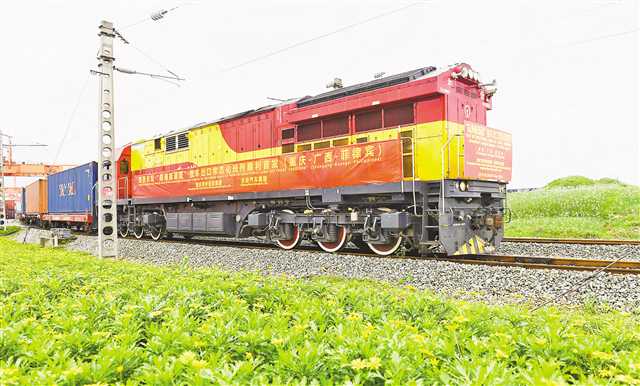


(Chongqing Daily/Luo Bin)
The New International Land-Sea Trade Corridor will inject strong impetus into the development of provinces and regions in western China thanks to enhanced connectivity.
Eight western Chinese provincial regions signed a framework agreement to cooperate in building the corridor, including Chongqing Municipality, provinces of Guizhou, Gansu, Qinghai and Yunnan, south China's Guangxi Zhuang Autonomous Region, northwest China's Xinjiang Uygur Autonomous Region and northwest China's Ningxia Hui Autonomous Region.
It is an international trade and logistics passage jointly built by western Chinese provinces and ASEAN countries under the framework of the China-Singapore (Chongqing) Demonstration Initiative on Strategic Connectivity.
With Chongqing as the transportation hub, the land-sea corridor uses ports in Guangxi's Beibu Gulf to reach ports in Singapore and other ASEAN countries and links China-Europe freight trains. In this way, it enables transportation from western China to more regions across the world utilizing various transportation options including rail, road, water and air routes. It links 191 ports in 80 countries and regions worldwide.
By the end of July this year, a total of 1,183 freight trains between Chongqing and Beibu Gulf via the corridor had been launched, transporting $630 million worth of foreign goods and 3 billion yuan ($430 million) worth of domestic goods. 1,460 lorries had been launched via the Chongqing-ASEAN Regular Lorry Service, part of the corridor, delivering 1.2 billion yuan worth of goods in total.
More than 300 varieties of products from Chongqing, including complete vehicles and spare parts, building ceramics, and raw chemical materials, are exported to over 180 countries around the world via the corridor. Meanwhile, high-quality agricultural products are regularly imported to Chongqing.
To ensure greater success of the corridor, the eight provinces and regions have agreed to facilitate the construction of railways and logistics infrastructure and improve management of goods.
 Fire brigade in Shanghai holds group wedding
Fire brigade in Shanghai holds group wedding Tourists enjoy ice sculptures in Datan Town, north China
Tourists enjoy ice sculptures in Datan Town, north China Sunset scenery of Dayan Pagoda in Xi'an
Sunset scenery of Dayan Pagoda in Xi'an Tourists have fun at scenic spot in Nanlong Town, NW China
Tourists have fun at scenic spot in Nanlong Town, NW China Harbin attracts tourists by making best use of ice in winter
Harbin attracts tourists by making best use of ice in winter In pics: FIS Alpine Ski Women's World Cup Slalom
In pics: FIS Alpine Ski Women's World Cup Slalom Black-necked cranes rest at reservoir in Lhunzhub County, Lhasa
Black-necked cranes rest at reservoir in Lhunzhub County, Lhasa China's FAST telescope will be available to foreign scientists in April
China's FAST telescope will be available to foreign scientists in April "She power" plays indispensable role in poverty alleviation
"She power" plays indispensable role in poverty alleviation Top 10 world news events of People's Daily in 2020
Top 10 world news events of People's Daily in 2020 Top 10 China news events of People's Daily in 2020
Top 10 China news events of People's Daily in 2020 Top 10 media buzzwords of 2020
Top 10 media buzzwords of 2020 Year-ender:10 major tourism stories of 2020
Year-ender:10 major tourism stories of 2020 No interference in Venezuelan issues
No interference in Venezuelan issues
 Biz prepares for trade spat
Biz prepares for trade spat
 Broadcasting Continent
Broadcasting Continent Australia wins Chinese CEOs as US loses
Australia wins Chinese CEOs as US loses